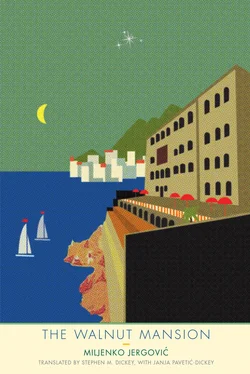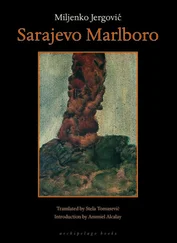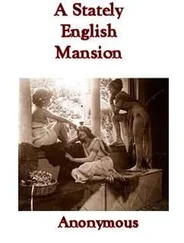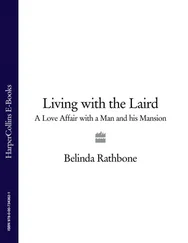The idea of Yugoslavia gained political momentum during the First World War, and the end of the war in 1918 saw the creation of the Kingdom of the Serbs, Croats, and Slovenes, which was soon plagued by ethnic antagonisms. Royal Yugoslavia hobbled along until the Axis invaded the country in April 1941, in preparation for its attack on the Soviet Union. Hitler’s conquest of Yugoslavia was followed by four years of unprecedented bloodletting, but most Yugoslav casualties were victims of their compatriots. In particular, in the fascist Independent State of Croatia Ante Pavelić’s Ustashas (including both Croats and some Bosniaks) exterminated Jews, Serbs, and Roma; in eastern Bosnia, Draža Mihailović’s Serbian guerillas (Chetniks) massacred large numbers of Bosniaks. Josip Broz Tito’s Soviet-backed Partisans fought both the Ustashas and at times the Chetniks in their war against the Nazis. These names and terms are mentioned repeatedly in the novel.
After the Second World War, Tito and his communist Partisans took control of the country. Yugoslav communism was not as repressive as Soviet (and especially Stalinist) communism, and Tito’s postwar policies soon earned him the ire of the Soviets, culminating in a tense Soviet-Yugoslav split in 1948, which was welcomed by the West. Tito then steered Yugoslavia on its own independent course, while remaining committed to socialism. His international promotion of the Non-Aligned Movement can be seen as elevating the frontier mentality of the region to the level of global political ideology. After Tito’s death in 1980, it seems in retrospect only to have been a matter of time before the country broke up, as communist Yugoslavia failed badly in the economic sector and also failed (as had its interwar predecessor) to create an identity to replace the ethnic loyalties of its citizens. That time came in 1991, when Slovenia and Croatia seceded from the country, which had come under the control of the Serbian nationalist technocrat Slobodan Milošević; Bosnia and Herzegovina followed suit in 1992. Bloodletting reminiscent of the Second World War followed as well and was particularly vicious in Bosnia, a situation that led Jergović to leave Sarajevo and settle in Croatia. The outbreak of war in Croatia and the shelling of Dubrovnik by Serbian and Montenegrin forces in 1991 are mentioned in passing late in the chronological time of the novel (which is early in the story, as it is told in reverse).
If Jergović is a quintessential Balkan storyteller, his literary horizons nevertheless lie far beyond that region. In his interview with Slobodna Dalmacija , he revealed some noteworthy outside influences, including Zadie Smith and Jonathan Franzen, as they “prove that there is such a thing as an epic of the new millennium and that it makes sense to tackle the big themes on a scale that calls a motion picture to mind.” In addition to other print influences (ranging from Fernand Braudel’s theory of history to Baedeker travel guides), Jergović emphasizes the influence of film (Italian Neorealism and Fellini’s Amarcord, as well as the work of Douglas Sirk) and music (Arab, Latin American, Roma, and the lyrics of Bosnian sevdah and Croatian klapa songs).
These self-acknowledged connections place Jergović not only in the Yugoslav cosmopolitan milieu that was open to Western influences (and one might consider a “Central European” current in Yugoslav culture), but also in the specifically Balkan (i.e., indigenously Southeast European and/or post-Ottoman) culture of the region. He is less a part of its Orthodox element.
The Walnut Mansion falls into a rich tradition of the family saga in modern world literature, and I think it is indisputably a rewarding read even for those with no knowledge of the former Yugoslavia. However, in what follows I focus mostly on aspects of the novel as they relate to the literary and political contexts of the former Yugoslavia. The novel is extremely interesting with regard to the post-Yugoslav “space” and deserves some comment in this regard.
There have been relatively few works that could count as family sagas in the literatures of Croatia, Bosnia, and Serbia. In Croatian literature, Vjenceslav Novak chronicled the fall of a noble family in Senj on the Adriatic coast in The Last of the Stipančićes, and Miroslav Krleža chronicled the rise and fall of the Glembaj family in eleven short stories and three plays. (One might also mention here Ivo Vojnović’s Dubrovnik Trilogy, which, though not a family saga, narrates the demise of the Republic of Dubrovnik and the Dubrovnik nobility, which is echoed in the narrative of a Dubrovnik family in The Walnut Mansion. ) Some important single-work representatives of the genre come from Serbian literature: Ivo Andrić’s The Woman from Sarajevo and Mirko Kovač’s The Door of the Womb; one might argue for the inclusion of Borisav Stanković’s The Tainted Blood. None of these novels really covers more than two generations of a family, and in this respect The Walnut Mansion, with its span of five generations, appears to be unique.
As mentioned, The Walnut Mansion is also remarkable for its focus on female characters, as well as the prominence of female psychological narrative. Into the twentieth century most South Slavs lived in patriarchal societies, and their fiction tended to focus on male characters and values, even when criticizing a patriarchal social order (a perfect example of this is Krleža’s On the Edge of Reason ). It is interesting that some notable exceptions to the trend of dominant male characters come from Serbian literature, where the patriarchal social order has been slow in dying out. Here one can mention Stanković’s The Tainted Blood, Miloš Crnjanski’s Migrations, and Andrić’s The Woman from Sarajevo. The Walnut Mansion differs from the first two in that Jergović is not portraying women of exceptional physical beauty (in fact, Regina’s looks are barely described in the novel). It does bear a strong resemblance to Migrations because Regina is the prism through which the narratives of numerous male characters are viewed, just as Dafina in Migrations is ultimately the glue that holds the narratives of the brothers Vuk and Aranđel Isaković together.
Though The Woman from Sarajevo is a rather odd tale of a misanthrope, it anticipates the major theme of The Walnut Mansion: the effect of cataclysmic historical events on an ordinary woman. The withdrawal of the protagonist of The Woman from Sarajevo from society after the First World War arguably subdues this theme, whereas The Walnut Mansion almost continuously foregrounds the watershed events of history and their effect on Regina’s life, beginning with the First World War, continuing with the Second World War and various postwar events such as the death of Josip Broz Tito. The conduct of Jergović’s female characters in these events differs greatly from that of the men in their lives, who with one or two exceptions see these events as opportunities for enrichment, adventure, or revenge and almost inevitably perish, leaving their women to fend for themselves.
With this in mind, one could describe The Walnut Mansion as a kind of “her-story” of life in twentieth-century Yugoslavia. In one of the bloody climaxes of the novel, the narrator even directly comments on the differences between the sexes with regard to history: “Men write history with knives, and women summon it with words.”
Regina’s brother Luka, selling cheese at a market, makes a like-minded comment on historical greatness and the attitudes of the sexes toward it:
The real truth of history hasn’t been written down, but as there are no living witnesses, it’s simplest to say that Napoleon never ate lunch or dinner like ordinary people. Instead of eating, he conquered the world. Instead of drinking, he waged war. So was Napoleon, my good people, a great man? Well, missus, you tell me: would you rather have your husband grab a rifle and shoot up the street, kill all the neighbors, and go on a war of conquest instead of lunching on those delicious mackerels you’ve bought?
Читать дальше
